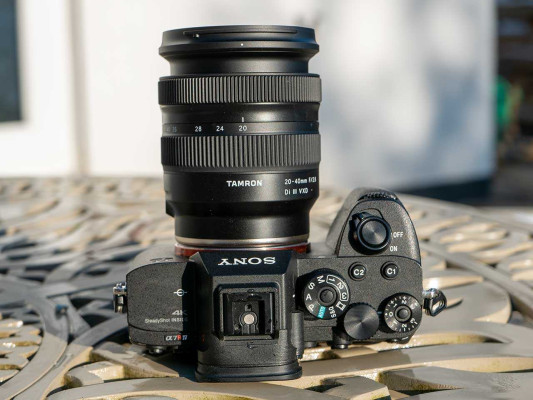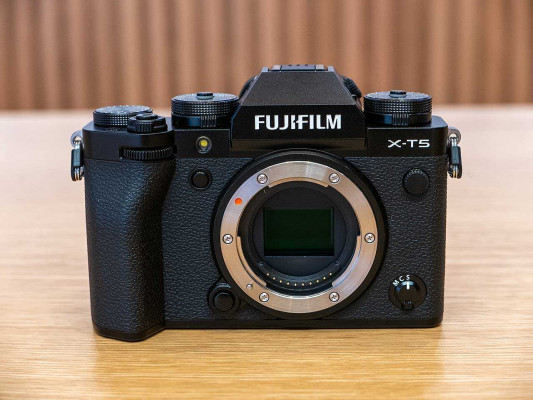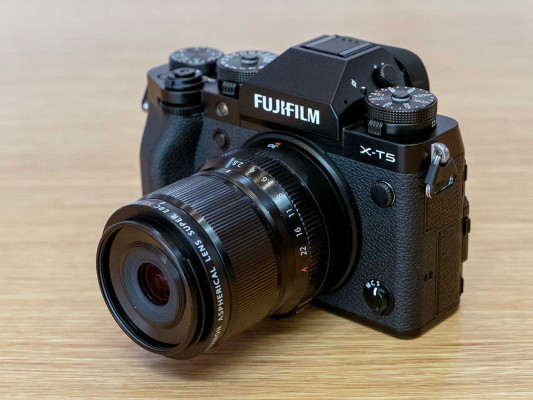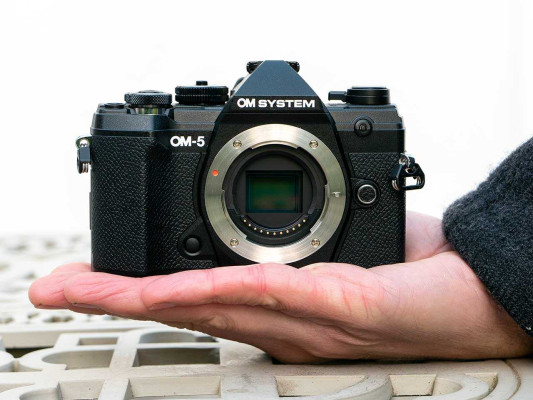Reviews

Panasonic Lumix DC-S5 II initial review
DPReview Latest |
Product images by Richard Butler
The Panasonic Lumix DC-S5 II is the company's latest version of their mid-range full-frame stills and video mirrorless camera. It adds phase detection autofocus to its 24MP CMOS sensor and uses the L mount shared with Leica and Sigma.
Panasonic also announced the DC-S5 IIX, a variant with a more extensive video feature set, which will arrive later in the year.
Key specifications
- 24MP BSI CMOS sensor with on-sensor phase detection
- Up to 30fps e-shutter shooting with C-AF and Raw capture
- 96MP multi-shot high-resolution mode
- 6K 3:2 open-gate video capture up to 30p (4:2:0 10-bit)
- 6K or DCI/UHD 4K from full sensor width up to 30p
- DCI/UHD 4K up to 60p (S35), unlimited record times
- Dual conversion gain sensor with explicit 'Dual Native ISO' gain selection
- Cooling fan
- Twin UHS-II card slots
- Optional paid upgrade for Raw video output
Additional features in S5 IIX
- Raw video output
- Video recording to SSD over USB
- All-I compression modes
- Internal ProRes capture
- Wired/wireless IP streaming
The S5 II will be available from the last week of January for a recommended price of $1999 (€2199), with the S5 IIX not hitting the shelves until the end of May. The S5 IIX will command a $200 (or €300) premium over the less video-centric version.
An optional paid upgrade for the S5 II will add Raw video output, and will cost $200/€200.
Jump to:
What's new? | How it compares | Body and controls | Initial impressions | Sample gallery | Specifications | Press release
What's new?
 |
Phase detection AF
The biggest news is the inclusion of on-sensor phase detection: a technology Panasonic has not previously used. Phase detection essentially works by generating two views of the scene from slightly different perspectives (typically by forming separate images that 'look' through the left and right sides of the lens) and comparing them. Just as with human vision that uses two eyes set apart from one another, this enables the camera to establish an understanding of distance and depth in the scene.
Comparing the two images lets the camera calculate how far it needs to drive focus in order to bring the two perspectives into alignment, at which point the aligned subject is in focus. This is especially valuable in video mode, as it allows the camera to refocus to a different distance without overshooting and also, critically, means the camera can check that it's still in focus without having to move the lens. This means phase detection can be decisive in situations where it must hold focus, as it can confidently stay there.
Panasonic says it helps to improve tracking ability, performance in low light levels and backlit conditions and when dealing with multiple subjects (staying locked on your chosen subject better because it knows which one in the scene it is).
Subject recognition AF
In the S5 II, Panasonic has combined its newfound depth awareness with an enhanced version of its existing subject recognition tracking system, which has been trained to recognize both humans and animals.
There are three distinct recognition modes that narrow down your intended subject type, to maximize your success rate. Human + Animal tracking mode is the broadest and will track any of the subjects it's been trained to recognize, and we're told will prioritize animals. Human mode has a hierarchy of subjects it can detect, with the highest priority being eyes, then faces, then heads, then bodies; it will focus on the most important of these it can find. Finally, Face/Eye detection solely focuses on eyes and faces in the scene.
In all three modes, the camera will start searching from your selected AF point and the area immediately around it, meaning It will focus on the specified subject type if it's found under your AF point. This system makes it possible to use the AF point to specify an individual subject in a group (you can also change its mind by tapping on the screen or using the joystick to jump between recognized faces). It also means you can leave Face/Eye detection on to specify a non-human subject, without the camera automatically giving precedence to any people in the frame. Note that when your AF area is the whole screen, Face/Eye mode will choose to focus on someone facing the camera, not simply the nearest human if can detect.
Updated in-body image stabilization
 |
Panasonic has also improved its image stabilization system, promising a performance twice as effective as in the S5. For its revised system it's adopted the branding 'Active IS,' though it hasn't been very specific about how these improvements have been achieved.
What the company has said is that its algorithms have been re-worked and that the camera assesses camera motion more precisely. We've been impressed with what we've seen from the S5 II so far, in terms of keeping both stills still and video clips smooth. The Boost IS mode, which tries to cancel all movement for a tripod-like video look, is particularly impressive.
The stabilization system also underpins the eight-shot 96MP High Resolution mode. The S5 II doesn't have the hand-held high-res mode from the GH6, and so requires a tripod or otherwise fixed camera, but it still offers a motion correction mode for preventing artifacts from moving subjects in the scene.
New processor
At the heart of the S5 II is a new processing engine that is the first product of Panasonic's L² co-development project with Leica. The two companies shared know-how and resources to develop the new processor, which we'd expect to see in future Leica models, too.
While Panasonic says the sensor in the S5 II is also new, from what we've seen its performance appears to be similar to its non-phase-detect predecessor, which suggests that its newfound ability to shoot at up to 30fps in e-shutter mode is more about having a processor able to cope with this speed.
Built-in fan
 |
The S5 II includes a fan mechanism, to allow video shooting for extended periods. The fan is at the top of the camera, with vents under the leading edge and along the sides of the viewfinder hump, drawing the heat up and out of the camera. As usual, the fan sits outside the body's sealed area, so the vents aren't a weak point for its dust and splash resistant design.
The fan means the S5 II can record for unlimited periods in most of its video modes, as tested by Panasonic at temperatures of 40°C (104°F). Panasonic points out that most of its rivals only quote figures for 22–25°C (72–77°F), which is significantly less demanding and less representative of average temperatures across much of the US.
Video
 |
The S5 II builds on the video capabilities of the S5, despite using a chip with similar ˜21ms readout times for its 16:9 footage.
The most obvious addition to the camera's capabilities is the ability to shoot full sensor height 3:2 'open gate' video. This is available at up to 30p and provides the scope to crop into various aspect ratios or to pan around the frame in post. Alternatively there are 6K options, either in UHD-style 16:9 aspect ratio or the DCI-like 18.9:1 format.
Beyond this are the full-width 4K modes (both DCI and UHD) which are taken from 6K capture. These are offered at up to 30p and up to 10-bit 4:2:2 encoding.
| Aspect ratios | Frame rates | Bit-depth | Chroma | Max bitrate | |
|---|---|---|---|---|---|
| Open gate 3:2, full width |
3:2 | 29.97, 25, 24, 23.98 | 10-bit | 4:2:0 | 200 |
| 6K full-width | 16:9, 1.89:1 | ||||
| 4K full-width | 4:2:2 | 150 | |||
| 4K APS-C | 59.94, 50, 29.97, 25, 24, 23.98 (48, 47.95) |
200 | |||
| 3.3K APS-C Anamorphic | 4:3 | 50, 29.97, 25, 24, 23.98 (48, 47.95) |
Panasonic's rivals have increasingly added 10-bit capture capability in this class, but the S5 II goes beyond these with a range of support tools and features that aren't as commonplace amongst the competition, so far.
Panasonic is still unique in this part of the market in providing the S5 II with a waveform display and vectorscopes. These are video-industry standard ways of understanding the tone and color distribution in the image, and can be hugely valuable when setting exposure and white balance. Likewise, the S5 II can express its exposure time in terms of shutter angle, which makes it easier to maintain a sensible exposure when switching between capture frame rates.
 |
| You may not notice them at first, but the finned vents of the fan on either side of the viewfinder show that the S5 II is serious about video. |
Syncro scan (the fine-tuning of exposure time to better sync with flickering light sources) is becoming more common, as are the option of four-channel audio capture and more video focused settings display screens. The S5 II's distinctly Arri-like screen, borrowed from Panasonic's Varicam line, is particularly clean and clear, though. Likewise, the ability to capture 4-channel audio (with an optional XLR adapter) is becoming more common, but the S5 II includes options such as line-level input and dual input gain settings on its mic inputs that its rivals lack.
The S5 II gains a couple of additional functions, including 'Full-range HLG' shooting. This ignores the upper and lower brightness limits that are imposed by the HLG standard, meaning you retain a little more flexibility in the edit. This is handy both if you have HLG as your final intended output or if you're using it as a Log-like intermediate step.
Anamorphic support
Tying-in with the S5 II's ability to capture open-gate and 4:3 APS-C footage is a good selection of tools to support shooting with anamorphic lenses. As on previous Panasonic models, the S5 II can stretch the footage horizontally to give a real-time 'desqueezed' preview for a wide variety of squeeze factors. The camera can then plot safe-zone markers for various output aspect ratios over the top of this view, so you know you're capturing the action in a part of the frame that will be used in your final footage.
Telling the camera the squeeze ratio of your lens also allows the S5 II to adjust its image stabilization system to accommodate the differing effective focal lengths of your vertical and horizontal capture, improving the stabilization performance.
LUT-applied shooting
The S5 II gains the ability to import LUTs in the industry-standard .CUBE format (in addition to Panasonic's own .VLT type). It can store up to 10 LUTs and adds the ability to apply the LUT to the footage as you shoot. Doing do means you lose post-processing flexibility, putting greater emphasis on getting exposure and white balance right in-camera, but it lets you achieve the look you want straight out of camera.
S5 IIX features
All the differences between the S5 II and S5 IIX have to do with the latter's video capabilities. The X's body has a rather nice all-mono design with blacked-out 'Lumix' branding and no red accents on the control dials, but in almost every other regard, the two look the same.
Under the hood the S5 IIX brings enhanced video modes that are better suited to extensive post-production work.
- Raw video output
- Internal ProRes capture (422 and 422 HQ)
- All-I codecs
- USB-SSD output
- Direct wired and wireless streaming (per GH5 II)
S5 II owners can buy an upgrade to add Raw video out for their camera, but it won't come with the other enhancements of the S5 IIX. In the US, at least, the paid upgrade costs the same as the difference in cost between the two models, so unless you desperately need the S5 II on a shoot immediately, it would appear to make more sense to wait until May for the X to start shipping.
How it compares
Like the S5 before it, the S5 II is clearly aimed at the same $2000-2500 mid-range full-frame audience. It's perhaps the most competitive segment of the market, packed with capable cameras that are adept at both stills and video shooting. This makes it difficult to stand out, and means that real-world AF performance and usability become the difference between an impressive spec list and a great camera.
| Panasonic Lumix DC-S5 II | Canon EOS R6 Mark II | Sony a7 IV | Nikon Z6 II | |
|---|---|---|---|---|
| MSRP at launch, body only | $1999 S5 IIX: $2199 |
$2499 | $2499 | $1999 |
| Pixel count | 24MP | 24MP | 33MP | 24MP |
| AF technology | PDAF + DFD | Dual Pixel AF | PDAF | PDAF |
| IBIS rating | Body: 5EV w/lens: 6.5EV |
Body: 8EV w/lens: 8EV |
5.5EV | 5EV |
| Burst rate | 30fps e-shutter 7fps mech (C-AF) |
40fps e-shutter 12fps mech |
10fps | 14fps |
| Viewfinder res | 3.68M dot OLED 0.78x |
3.69M dot OLED 0.76x |
3.68M dot OLED 0.78x |
3.69M dot OLED 0.8x |
| Rear screen | 1.84M dot fully-articulated | 1.62M dot fully-articulated | 1.04M dot fully-articulated | 2.1M dot tiltling |
| Battery grip option | Yes (DMW-BGS5) |
No | Yes (VG-C4EM) |
Yes (MB-N11) |
| Video resolution options | 6K 3:2 <30p 6K/5.9K <30p DCI/UHD <30p DCI/UHD <60p (1.5x crop) |
UHD <30p UHD <60p (sub-sampled) |
UHD <30p UHD <60p (1.5x crop) |
UHD <30p UHD <60p (1.5x crop) |
| Compresson options | H.265 H.264 Long GOP |
H.265 H.264 Long GOP |
H.265 H.264 LongGOP H.264 All-I |
H.264 Long GOP |
| S5 IIX: H.264 All-I ProRes (422 /422 HQ) |
||||
| Rolling shutter rate (UHD/24) |
21ms | 17ms (sub-sampled) |
27ms | 21ms |
| Movie features |
4 ch audio* |
4 ch audio* Zebras Peaking Raw video output |
4ch audio* Focus map Breathing compensation Zebras Peaking Raw video output |
Zebras Peaking Raw video output |
| HDMI type | Full-sized (Type A) | Micro (Type D) | Full-sized (Type A) | Mini (Type C) |
| Battery life rating (EVF / LCD) | 370 / 370 | 320 / 580 | 520 / 580 | 340 / 410 |
| Dimensions | 134 x 102 x 90mm | 138 x 98 x 88mm | 131 x 96 x 80mm | 134 x 101 x 70mm |
| Weight | 740g (26.1oz) | 588g (20.7 oz) | 658g (23.2 oz) | 705g (24.9 oz) |
All four cameras are clearly well specced, with only a few features helping set the models apart. Canon and Panasonic both offer rapid burst shooting rates, with the EOS R6 II achieving the faster rate with less rolling shutter and a pre-burst mode. The Canon leads the pack in terms of image stabilization rating, but this doesn't mean it offers the smoothest stabilization in video.
Image quality is broadly comparable, with the Sony offering slightly better detail capture at low ISO but slipping a little behind in low light conditions. The Sony offers the most impressive battery life but also the weakest rolling shutter performance in video, making it more difficult than ever to choose between the four cameras.
The S5 IIX will offer a broader range of video capabilities than any of the other current models, at a lower introductory price than either the Sony or Canon offerings.
Body and handling
 |
The styling of the S5 II is very much in keeping with that of the original model: it's a mid-sized, fairly squared-off design with a very distinct SLR-like shape to it (compared, say, to Nikon's Z-series cameras). Despite being the smaller model in the company's L-mount lineup, it has extensive external control points, including details such as a dedicated AF mode switch, that are unusual at this level.
Despite the familiar appearance, a lot has been redesigned or reworked. The most significant change is the addition of the fan to the camera's viewfinder hump. This is central to the camera's promises of video endurance, but is designed not to undermine the body's weather sealing.
 |
Beyond this, the S5 II gains a higher-resolution 3.68M-dot OLED viewfinder, and eight-way AF joystick (rather than the four-directional one on the original S5), and a full-sized HDMI port.
The S5 II also sees its second card slot upgraded to the UHS-II standard, allowing the use of faster SD cards in both slots. Notably, even with the fastest V90-rated cards, UHS-II isn't fast enough to record all the S5 IIX's video modes, with the most demanding of its All-I capture modes and all its 4K and 5.8K ProRes modes requiring the use of an external SSD. Panasonic says it's been working with third-party accessory makers to provide useful ways to attach popular SSDs to the camera.
There is enough commonality between the S5 and the Mark II that the new camera can still use the existing DMW-BGS5 battery grip, providing space for a second battery.
Battery
 |
| There's no separate charger with the S5 II but the Type 3.2 Gen 2 USB port can be used to charge, power or power and charge the camera. |
The S5 II continues to use the DMW-BLK22 battery from the previous version, which means it's also fully compatible with the same AC adaptor, DC coupler and dedicated battery chargers as the Mark I.
The S5 II does not come with its own charger and instead used the USB-PD standard to allow in-camera charging, operation or operation and charging, when connected to high-current power sources.
The camera's battery life rating is a rather disappointing 370 shots per charge, per CIPA standard testing methods. As always, these numbers tend to significantly underestimate how many shots you can typically expect (unless your shooting style is very energy-intensive). A 370 shot-per-charge rating will typically give you plenty of charge for a day's shooting, but you'll want to keep a USB power source near to hand for intensive shoots. A power-saving mode gives a rating of 1,250 shots per charge for viewfinder shooting.
Initial impressions
 |
The Lumix DC-S5 II reminds me of the lenticular prints sold in museum gift shops, which show a different image depending on the angle from which you view them. From one perspective it appears to be the two-year-old S5 with phase detection added, but looked at from a different position, its specs make it look like a credible competitor to Canon's recent EOS R6 II (which we consider to be the best of the current enthusiast full-frame bunch).
It may seem odd that the addition of phase detection (and a fast e-shutter burst mode) could make this much difference, especially when the previous AF system worked very well for some tasks. But that gives some impression both of how tight the differences are between best and worst in this class and how significant the addition of a capable stills and video AF system can be.
As with just about every other manufacturer we've spoken to in the past year, Panasonic says the S5 II is aimed at social media 'content creators,' but it's not entirely clear what it's done to deliver that, beyond building a camera that tries to shoot both stills and video. But I'm a little more convinced when it says the S5 II is intended just as much for stills as video.
What about the S5 IIX?Just as the improved AF significantly changes the S5 II's competitiveness, a relatively small number of feature additions make the S5 IIX stand out far more than the $200/€300 price difference might lead you to expect. The S5 II's fan already promises more reliable video capture device than any of its rivals, but the S5 IIX's range of capture options pushes it out beyond the competition. It's not alone in offering Raw output on All-I capture, but no other full-framer offers ProRes capture, nor the option for SSD output in this class. Each of these capabilities makes the S5 IIX look like a much more flexible production tool, despite a competitive price. |
Video is certainly one of Panasonic's recognized strengths, but it's important not to mistake attempts to bolster those capabilities for being solely video-focused. The inclusion of stills-specific features like its 30fps burst speed, pixel-shift high-res mode and live view composite options go a long way toward making it a true hybrid camera, as happy and capable at shooting stills as capturing video. And while the existing DFD AF system worked well for single stills, a refreshed AF tracking system can only expand the S5 II's appeal to the stills shooter.
Does the S5 II do enough to be seen as a serious contender to the likes of Canon's EOS R6 II or even Nikon's Z6 II? It helps its case that Leica, Panasonic and Sigma are doing a good job of building a system around the L-mount, meaning there are many more native lenses available than for Canon or Nikon's mirrorless systems.
Ultimately, though, the S5 II seems likely to succeed or fail based on its AF performance. There's little reason to doubt it'll be a capable video camera, but the effectiveness of its revised AF system will help define how easy it is to shoot with for both stills and video, and in that department it's squaring up against some very capable competition.
Our first impressions are that the AF tracking in stills mode is stickier than the Nikon Z6 II's but a touch behind its Canon and Sony rivals, whereas for video it's better behaved than all but the Sony.
A potential pitfall is that one of its key stills features – 30fps Raw capture – exhibits significantly more rolling shutter than its most direct rival. The Canon EOS R6 II can shoot at 40fps with a readout time of ~18ms: around 30% quicker than the roughly 25ms the S5 II takes to close its shutter.
These are preliminary thoughts; we'll want to check the S5 II with more lenses in more shooting circumstances before drawing firm conclusions. Critically, it'll be a question of how well the stabilization and AF work together in run-and-gun video and stills capture. From our use so far, though, the S5 II appears to be in credibly me in the hunt. On that basis, it represents a big step forward for Panasonic, however you look at it.
Sample gallery
Please do not reproduce any of these images on a website or any newsletter/magazine without prior permission (see our copyright page). We make the originals available for private users to download to their own machines for personal examination or printing (in conjunction with this review); we do so in good faith, so please don't abuse it.































